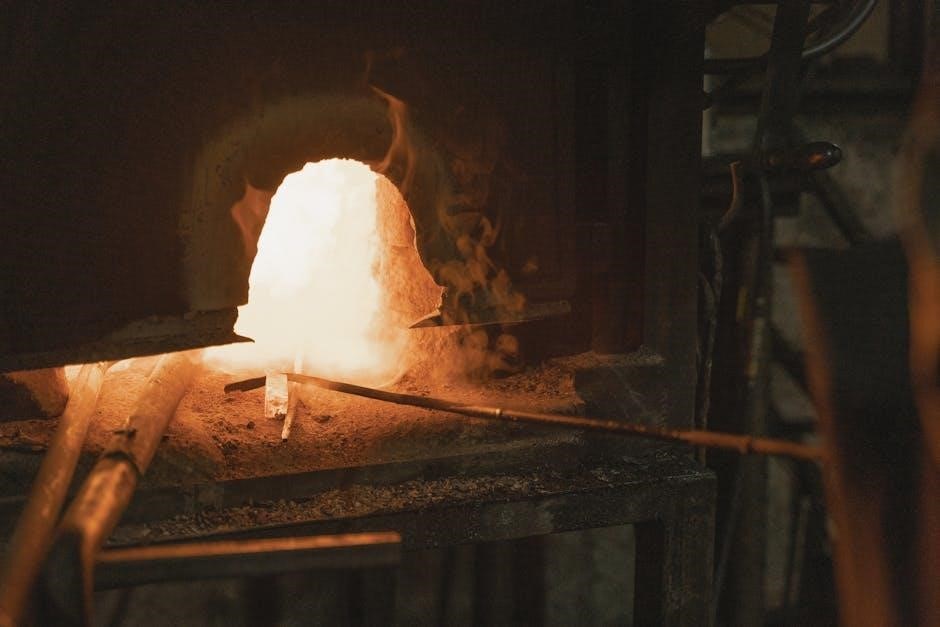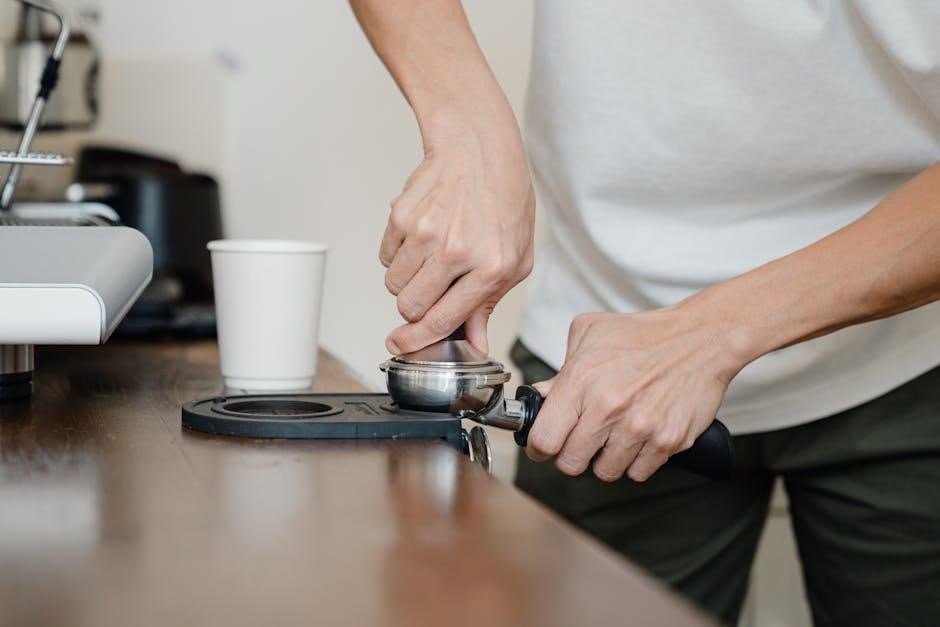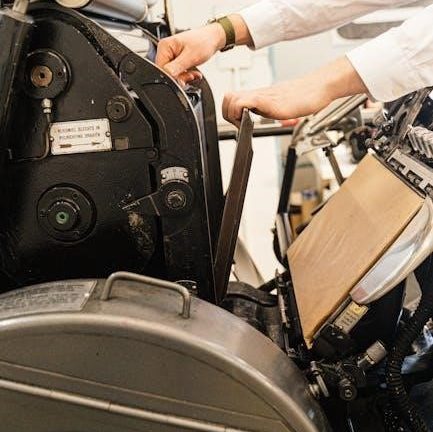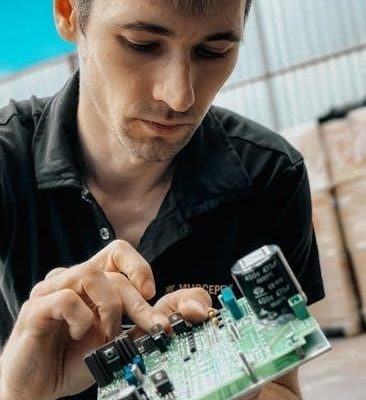A heat press is a versatile machine used to transfer designs onto materials like fabric‚ ceramics‚ and metal using heat and pressure. This manual guides you through its safe and effective operation‚ ensuring optimal results for various crafting and industrial applications.
1.1 What is a Heat Press?
A heat press is a machine designed to transfer designs‚ patterns‚ or text onto various materials like fabric‚ ceramic‚ metal‚ and plastic using heat and pressure. It is widely used in crafting‚ fashion‚ and industrial applications; The machine consists of a heating element‚ a pressure plate‚ and a control panel to regulate temperature and time. Modern models often feature advanced components such as touch screens‚ microprocessors‚ and slide rails for precise and efficient operation.
1.2 Importance of Reading the Manual
Reading the manual is essential to ensure safe and effective operation of the heat press. It provides detailed instructions for setup‚ temperature control‚ and maintenance‚ helping you understand machine features and proper usage. The manual also includes troubleshooting tips and manufacturer recommendations to prevent damage and achieve optimal results. By following the guidelines‚ you can maximize performance‚ avoid common errors‚ and extend the machine’s lifespan.

Safety Precautions
Always follow safety guidelines when using a heat press to avoid injuries and damage. Ensure proper electrical connections‚ avoid overheating‚ and handle materials carefully to maintain a safe working environment.
2.1 General Safety Guidelines
Always wear protective gloves and eyewear when operating the heat press. Ensure the workspace is clear of flammable materials and well-ventilated. Keep children and pets away. Avoid loose clothing that could catch fire or get entangled. Never leave the machine unattended while in operation. Be cautious when handling hot surfaces to prevent burns. Follow all manufacturer guidelines for temperature and pressure settings. Regularly inspect the machine for worn or damaged parts and replace them promptly to ensure safe operation.
2.2 Electrical Safety Tips
Ensure the heat press is plugged into a grounded electrical outlet with the correct voltage rating. Never submerge the machine in water or expose it to excessive moisture. Avoid using damaged cords or loose connections. Keep the power cord away from heated surfaces. Always turn off the machine before cleaning or maintaining it. Use a surge protector to safeguard against voltage spikes. Regularly inspect electrical components for wear and follow manufacturer guidelines for electrical safety to prevent hazards.
2.3 Heat and Pressure Safety Measures
Always wear heat-resistant gloves when handling hot surfaces. Ensure proper ventilation to avoid inhaling fumes from materials. Keep loose clothing tied back and long hair secured. Never touch the heating element or press surfaces during operation. Use a spatula or tongs to remove items. Avoid overloading the press‚ as excessive pressure can cause damage. Place the machine on a stable‚ heat-resistant surface. Follow temperature guidelines in the manual to prevent overheating. Keep children and pets away during use.

Machine Components
The heat press consists of a touch control panel‚ microprocessor‚ slide rails‚ and pressing bed. These components ensure precise temperature‚ pressure‚ and operation for optimal performance.
3.1 Overview of Heat Press Parts
The heat press comprises essential components‚ including the heating element‚ pressure plate‚ and control panel. These parts work together to regulate temperature‚ apply pressure‚ and ensure even heat distribution. Regular maintenance of these components is crucial for extending the machine’s lifespan and ensuring consistent performance. Proper care and timely replacement of worn parts will enhance efficiency and output quality.
3.2 Touch Control Panel and Microprocessor
The touch control panel and microprocessor are central to the heat press’s operation‚ offering precise control over temperature‚ time‚ and pressure. The microprocessor ensures accurate digital settings‚ while the touch panel provides an intuitive interface for easy navigation. These features enable users to customize settings‚ monitor progress‚ and achieve consistent results. Advanced models may include preset options and real-time monitoring‚ enhancing efficiency and reliability for both novice and experienced users.
3.3 Slide Rails and Component Replacement
The slide rails on your heat press are designed for smooth operation and durability‚ ensuring even pressure distribution. They simplify component replacement by allowing easy access to internal parts. Regular lubrication of the rails is essential to maintain optimal performance. Over time‚ worn components can be replaced using the manufacturer’s guidelines‚ extending the machine’s lifespan and reducing downtime.

Setting Up Your Heat Press
Unpack and inspect the heat press for damage. Assemble if required‚ following the manual. Place it on a stable‚ heat-resistant surface‚ ensuring proper ventilation and workspace organization.
4.1 Unpacking and Initial Inspection
Carefully unpack the heat press from its box and packaging materials. Inspect all components for damage or defects. Ensure all accessories‚ like power cords and user manuals‚ are included. Verify that the press bed‚ touch panel‚ and slide rails are intact. Clean any protective coverings or residue from the machine. Check for loose connections or parts before proceeding to assembly or placement.
4.2 Assembling the Heat Press (if required)
Follow the manual’s assembly instructions carefully. Attach the slide rails to the press bed‚ ensuring proper alignment. Secure all bolts and screws tightly. Connect the touch control panel and microprocessor‚ if applicable. Double-check that all components are aligned and functioning smoothly. Test the machine at a low temperature to ensure correct operation before full use. Always refer to the manufacturer’s guidelines for specific assembly requirements.
4.3 Placement and Workspace Preparation
Place the heat press on a stable‚ heat-resistant surface‚ away from flammable materials. Ensure the area is well-ventilated to prevent inhaling fumes. Clear the workspace of clutter for safe operation. Use a thermal protection pad under the machine to protect surfaces from heat. Keep the user manual accessible for quick reference. Ensure the machine is level to maintain even pressure distribution. Wear safety gloves and test the press at a low temperature before full operation.

Operating the Heat Press
Operating the heat press involves setting the temperature‚ timer‚ and pressure according to the material being used. Use the touch screen panel for precise control and follow the manual’s guidelines for safe and efficient operation.
5.1 Turning On and Off
To operate the heat press safely‚ start by plugging it into a grounded outlet and ensuring all components are in good condition. Turn it on using the power button and allow it to preheat to the desired temperature. When finished‚ switch it off and unplug it. Always wait for the machine to cool down before cleaning or storing it. Regularly check for any damage or wear before turning it on.
5.2 Adjusting Temperature and Timer
Adjust the temperature based on the material you’re using‚ typically between 200°F and 400°F. Set the timer according to the manufacturer’s guidelines‚ usually 10 to 300 seconds. Use the control panel to make precise adjustments. Ensure the machine reaches the set temperature before starting the timer. Always refer to the material’s specifications to avoid damage. Proper calibration ensures even heating and pressure for optimal results.
5.3 Using the Touch Screen Panel
The touch screen panel allows easy control of temperature‚ timer‚ and pressure settings. Navigate through menus to select preset options or customize settings for specific materials. Start the pressing process with a single touch and monitor progress in real-time. The panel also displays error messages and maintenance alerts. Regularly update software for optimal performance and refer to the manual for troubleshooting tips. Ensure the screen is clean for accurate functionality.

Printing and Pressing
Prepare materials by aligning designs properly on the press bed. Ensure even pressure and heat distribution for consistent results. Start the pressing cycle and monitor progress.
6.1 Preparing Materials for Pressing
Properly prepare materials by ensuring designs align with the press bed. Always refer to the manufacturer’s guidelines for specific temperature‚ time‚ and pressure settings. Clean the press bed and materials to prevent contamination. Use high-quality transfers or inks for optimal results. Smooth out wrinkles and creases in fabrics before pressing to achieve a professional finish. Always test on a small sample first to avoid errors.
6.2 Placing Materials on the Pressing Bed
Center the material on the pressing bed‚ ensuring it aligns with the heat press’s center. Secure the design with thermal tape to prevent shifting during pressing. Position the substrate evenly‚ avoiding wrinkles or creases. Always refer to the manual for specific placement recommendations based on the material type. Ensure the pressing bed is clean and dry for optimal transfer quality. Proper alignment and secure placement are crucial for achieving professional results.
6.3 Starting the Pressing Process
Once materials are properly placed‚ set the temperature and timer according to the manufacturer’s guidelines for the specific material. Use the touch screen panel to input settings accurately. Close the press firmly and ensure the pressing bed is clean and dry. Press the start button to initiate the cycle. Allow the machine to complete the process without interruption. For models with auto-open features‚ the press will automatically lift. Always follow manual instructions for optimal results.

Advanced Features
Modern heat presses offer multi-functional capabilities‚ slide-out pressing beds‚ and automated features like auto-open‚ enhancing efficiency and ease of use for various substrates and projects.
7.1 Multi-Functional Heat Press Capabilities
Modern heat presses are designed to handle a variety of materials and projects‚ making them multi-functional tools for crafting and manufacturing. They can transfer designs onto fabrics‚ ceramic tiles‚ mugs‚ and even 3D objects like caps and plates. With adjustable temperature and pressure settings‚ these machines cater to different substrates‚ ensuring precise and consistent results. Their versatility makes them indispensable for both small-scale DIY enthusiasts and large industrial operations.
7;2 Using Slide-Out Press Beds
Slide-out press beds offer enhanced convenience and efficiency for larger or complex projects. They allow easy loading and unloading of materials‚ reducing strain and improving alignment accuracy. This feature is particularly useful for bulkier items like banners‚ canvas bags‚ or thick fabrics. The slide-out mechanism ensures even pressure distribution and simplifies the pressing process. Always refer to your manual for specific guidelines on using this feature effectively with your heat press model.
7.3 Auto-Open and Automated Features
Auto-open and automated features streamline the pressing process‚ enhancing productivity and safety. The auto-open function prevents overheating and ensures consistent results by automatically lifting the press at the end of the cycle. Automated timers and temperature controls allow for precise settings‚ reducing manual intervention. These features are ideal for high-volume tasks and minimize the risk of human error‚ ensuring professional-quality outcomes with minimal effort.

Maintenance and Upkeep
Regular cleaning‚ lubrication of moving parts‚ and replacement of worn components ensure optimal performance and longevity of the heat press. Follow manufacturer guidelines for maintenance routines.
8.1 Cleaning the Heat Press
Regular cleaning is essential for maintaining your heat press’s performance. Use a soft‚ dry cloth to wipe down the platen and pressure plates. For tougher residue‚ dampen the cloth with distilled water‚ but avoid harsh chemicals or abrasive materials that could damage the surface. Clean the touch control panel with a mild detergent solution. Always turn off and unplug the machine before cleaning‚ and allow it to cool completely to ensure safety and prevent damage.
8.2 Lubricating Moving Parts
Regular lubrication of moving parts ensures smooth operation and prevents wear. Turn off the machine and let it cool before lubricating. Use a silicone-based spray or oil on slide rails‚ hinges‚ and other moving components. Apply a small amount‚ then wipe off excess with a clean cloth to avoid residue buildup. Lubricate every 1-3 months depending on usage to maintain optimal performance and extend the machine’s lifespan.
8.3 Replacing Worn Components
Inspect the heat press regularly for worn parts‚ such as slide rails or hinges. When replacing‚ ensure the machine is turned off and cool. Use genuine replacement parts from the manufacturer for compatibility and safety. Refer to the manual for specific instructions. Apply a small amount of silicone-based lubricant after installation. If unsure‚ consult a professional or contact customer support to avoid further damage or malfunctions.

Troubleshooting Common Issues
Identify common issues like error messages or uneven pressure. Check temperature settings and ensure proper material placement. Consult the manual or contact support for unresolved problems.
9.1 Identifying and Solving Pressing Problems
Common pressing issues include uneven heat distribution‚ incomplete transfers‚ or machine malfunctions. Always check temperature and timer settings to ensure they match the material requirements. Verify proper placement of materials on the pressing bed and inspect for debris or misalignment. Consult the manual for troubleshooting guides or contact manufacturer support for unresolved issues to maintain optimal performance and achieve desired results.
9.2 Addressing Machine Malfunctions
If your heat press malfunctions‚ first power it off and unplug it. Check for loose connections or faulty sensors. Ensure the touch control panel is clean and responsive. Refer to the manual for diagnostic steps or contact manufacturer support for assistance. Regular maintenance‚ like lubricating moving parts‚ can prevent many issues. Always follow safety guidelines when troubleshooting to avoid further damage or injury.
9.3 Tips for Achieving Optimal Press Quality
To achieve optimal press quality‚ always follow the manual guidelines for temperature‚ time‚ and pressure settings. Clean the press bed regularly to prevent residue buildup. Use parchment paper or a Teflon sheet to protect materials and ensure even heat distribution. Preheat the machine before use and ensure the pressing surface is flat. Test settings on scrap material first. Avoid overheating‚ as it can damage both the machine and materials. Regular maintenance ensures consistent results and prolongs machine lifespan.

Additional Resources
Access user manuals‚ online tutorials‚ and manufacturer support for troubleshooting. Download guides from trusted sources like ManualsLib or the official manufacturer’s website for comprehensive assistance.
10.1 Downloading User Manuals
Download user manuals for your heat press machine from official manufacturer websites or platforms like ManualsLib. These manuals are available in multiple languages and formats‚ such as PDF‚ ensuring easy access to step-by-step instructions‚ troubleshooting guides‚ and technical specifications. Popular brands like HTVRONT‚ Hotronix‚ and Blue Press provide comprehensive manuals to help users optimize their machine’s performance and address common issues effectively. Always refer to the correct model-specific manual for accurate information.
10.2 Accessing Online Tutorials
Access online tutorials for your heat press machine through manufacturer websites‚ YouTube‚ or crafting platforms. These tutorials offer step-by-step guides for setup‚ operation‚ and troubleshooting. Brands like HTVRONT and Hotronix provide video demonstrations to help users master various techniques. Additionally‚ forums and community groups share tips and project ideas‚ ensuring you maximize your machine’s potential and achieve professional-quality results consistently. Online resources are updated regularly to address common queries and enhance user experience.
10.3 Manufacturer Support Contact Information
For assistance‚ refer to the manufacturer’s official website for contact details‚ including email‚ phone‚ and live chat options. Brands like HTVRONT and Hotronix provide dedicated support pages. Many manufacturers also offer FAQs and troubleshooting guides on their sites. Additionally‚ some companies provide contact forms for inquiries. Always verify the contact information from the manual or the manufacturer’s official website to ensure accuracy and prompt support for your heat press needs.
Mastering your heat press requires practice and adherence to the guidelines outlined in this manual. By following safety protocols‚ understanding machine components‚ and maintaining proper upkeep‚ you can achieve professional-quality results. Whether for personal projects or commercial use‚ consistent practice will enhance your skills. Refer back to this manual for troubleshooting and optimization tips‚ ensuring your heat press remains a reliable tool for all your creative and industrial needs.


